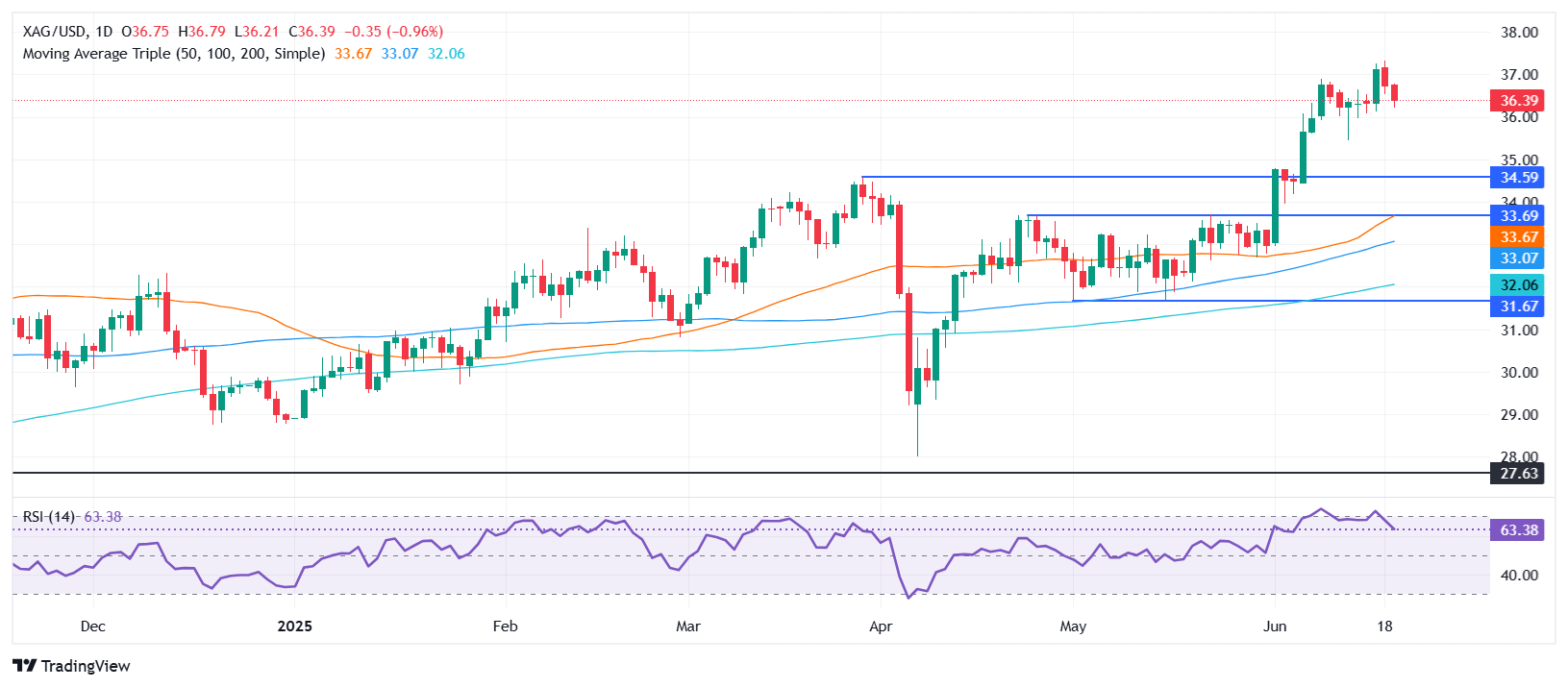Silver Price Forecast: XAG/USD dips below $36.50 on US Dollar strength
- Silver falls for the second day as the US Dollar climbs to 99.15 on geopolitical fears.
- RSI shows weakening momentum; the path of least resistance may shift lower.
- Key support at $36.00, while resistance looms at $36.50 and $37.32 YTD high.
Silver price retreats on Thursday after back-to-back bearish days, as investors seeking safety buy the US Dollar (USD), pushing the US Dollar Index (DXY) to a six-day high of 99.15. Rising tensions in the Middle East grow as the US could be dragged into the conflict. Currently, XAG/USD is trading at $36.37, down nearly 1%.
XAG/USD Price Forecast: Technical outlook
Silver prices remain upward biased, despite retreating to current levels after reaching a multi-year high of $37.32 on Wednesday. The gray metal hit a low around $36.21; since then, it has recovered, but traders are facing strong resistance at $36.50.
The Relative Strength Index (RSI) indicates that buyer momentum is fading, suggesting that the path of least resistance is downward in the near term.
With that said, the first support level for XAG/USD would be the $36.00 figure. On further strength, sellers could challenge Silver’s bullishness if they drag prices below the June 12 swing low of $35.46, which clears the path to test the October 30, 2024, high turned support at $34.86.
On the other hand, if XAG/USD prints a daily close above $36.50, the following key resistance levels would be $37.00 and the year-to-date high of $37.32.
XAG/USD Price Chart – Daily

(This story was corrected on June 19 at 21:02 GMT to say in the first bullet point that Silver falls for the second day, not the third)
Silver FAQs
Silver is a precious metal highly traded among investors. It has been historically used as a store of value and a medium of exchange. Although less popular than Gold, traders may turn to Silver to diversify their investment portfolio, for its intrinsic value or as a potential hedge during high-inflation periods. Investors can buy physical Silver, in coins or in bars, or trade it through vehicles such as Exchange Traded Funds, which track its price on international markets.
Silver prices can move due to a wide range of factors. Geopolitical instability or fears of a deep recession can make Silver price escalate due to its safe-haven status, although to a lesser extent than Gold's. As a yieldless asset, Silver tends to rise with lower interest rates. Its moves also depend on how the US Dollar (USD) behaves as the asset is priced in dollars (XAG/USD). A strong Dollar tends to keep the price of Silver at bay, whereas a weaker Dollar is likely to propel prices up. Other factors such as investment demand, mining supply – Silver is much more abundant than Gold – and recycling rates can also affect prices.
Silver is widely used in industry, particularly in sectors such as electronics or solar energy, as it has one of the highest electric conductivity of all metals – more than Copper and Gold. A surge in demand can increase prices, while a decline tends to lower them. Dynamics in the US, Chinese and Indian economies can also contribute to price swings: for the US and particularly China, their big industrial sectors use Silver in various processes; in India, consumers’ demand for the precious metal for jewellery also plays a key role in setting prices.
Silver prices tend to follow Gold's moves. When Gold prices rise, Silver typically follows suit, as their status as safe-haven assets is similar. The Gold/Silver ratio, which shows the number of ounces of Silver needed to equal the value of one ounce of Gold, may help to determine the relative valuation between both metals. Some investors may consider a high ratio as an indicator that Silver is undervalued, or Gold is overvalued. On the contrary, a low ratio might suggest that Gold is undervalued relative to Silver.



